
Transit Briefs: SBCTA, Metrolink, SEPTA, NJ Transit
Written by Carolina Worrell, Senior Editor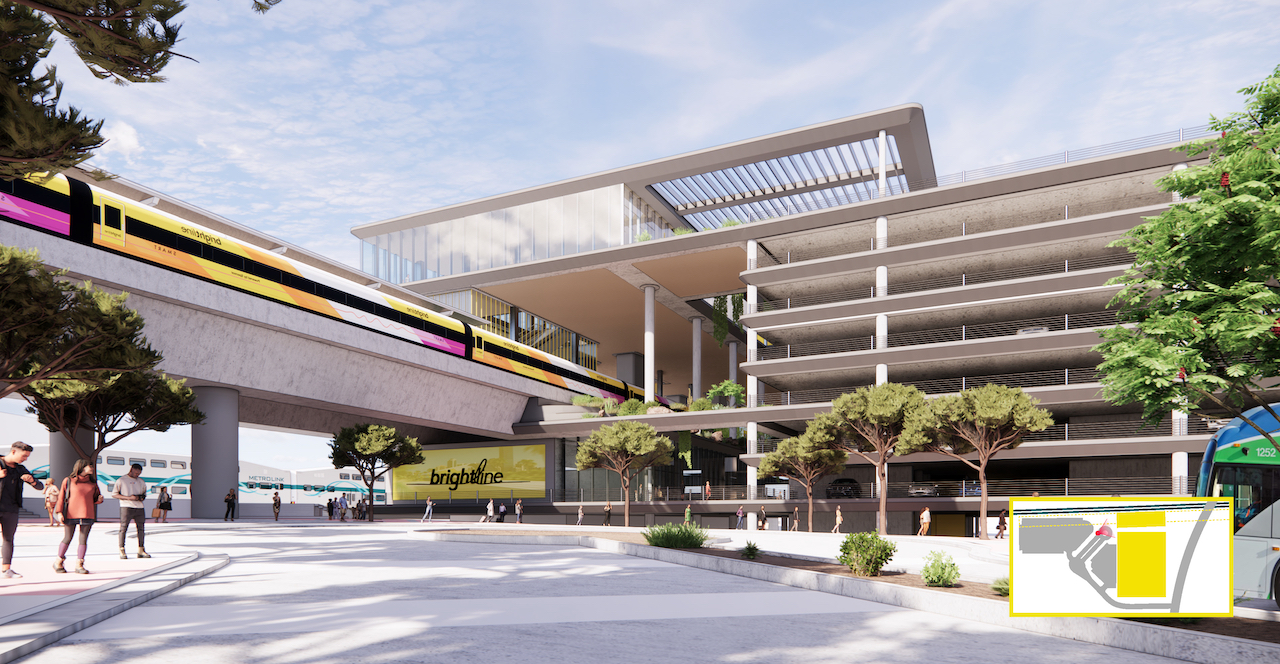
The Brightline West Cucamonga Station in Rancho Cucamonga, Calif., will be home to the first high-speed passenger rail service in the Inland Empire connecting Rancho Cucamonga, the High Desert and Las Vegas. (Graphic: Business Wire)
The San Bernardino County Transportation Authority (SBCTA) approves sale of Cucamonga Station property to Brightline West. Also, SBCTA and Metrolink announce ribbon cutting ceremony of Redlands Passenger Rail Project; Metrolink receives first American Public Transportation Association (APTA) certification for sustainability program; the Southeastern Pennsylvania Transportation Authority (SEPTA) expands institutional pass program; NJ Transit wins International Data Corporation (IDC) Best in Future of Digital Innovation Award; and NJ Transit breaks ground on Hoboken Connect project.
SBCTA
The City of Rancho Cucamonga City Council and the SBCTA Board of Directors have approved the first step of the sale of a five-acre portion of the jointly owned property at Cucamonga Station to Brightline West for development of the first high-speed rail station in the Inland Empire connecting Rancho Cucamonga, the High Desert and Las Vegas.
Cucamonga Station, which is located at the northwest corner of Milliken Avenue and Azusa Court, will “go through a transformation in the coming years, making it the region’s global connectivity point and destination location for everything California has to offer,” SBCTA says. Transportation modes at Cucamonga Station will provide service through high-speed rail, the Metrolink San Bernardino Line, and Omnitrans Bus Rapid Transit and local bus service, as well as serve carpool commuters. Plans are also moving forward for a sub-terranean loop to Ontario International Airport (ONT), led by SBCTA, where passengers will be transported “in just a few minutes” between Cucamonga Station and airport terminals, the Authority says. In anticipation of deploying this service, Omnitrans has launched ONT Connect, a regular shuttle service from Cucamonga Station to the airport that operates daily every 35-60 minutes, SBCTA adds.
“The public-private partnership between Rancho Cucamonga, SBCTA and Brightline West will help transform the region through an exciting multi-modal transportation hub in the heart of the Inland Empire,” said City of Rancho Cucamonga Mayor Dennis Michael. “Cucamonga Station aligns with our city’s quest to anticipate and embrace the future, relentlessly pursue improvement, and promote a safe and healthy community for all.”
The Cucamonga Station will be strategically located within the HART District–a new transit-oriented, mixed‑use, housing, retail and commercial district that “elevates the area into a walkable, culture-rich experience.” Located within the area of Haven Avenue, Arrow Route, Rochester Avenue and the Transit station in Rancho Cucamonga, it will serve as “a crossroads of food, travel, culture and commerce.” The HART District, SBCTA adds, is “poised to be the next key economic catalyst in the region.”
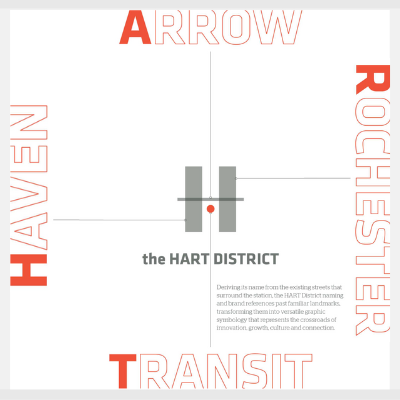
The City of Rancho Cucamonga, Greater Ontario Convention & Visitors Bureau (GOCVB), Omnitrans, the Ontario International Airport and San Bernardino County have established a joint effort for the project development and outreach programs. Additional project partners, SBCTA says, will come on board as the project continues to move forward through the development process.
“This agreement is a culmination of several years of working together with our partners and is a key milestone to bring high-speed rail to the Inland Empire,” said John Gillison, City Manager for the City of Rancho Cucamonga. “Cucamonga Station will serve as a global connectivity anchor within the newly branded HART District.”
“We are pleased to take this next important step forward in bringing enhanced transit connectivity to one of the fastest-growing population and economic centers in the country,” said Art Bishop, President of the SBCTA Board of Directors and Mayor Pro Tem of the Town of Apple Valley.
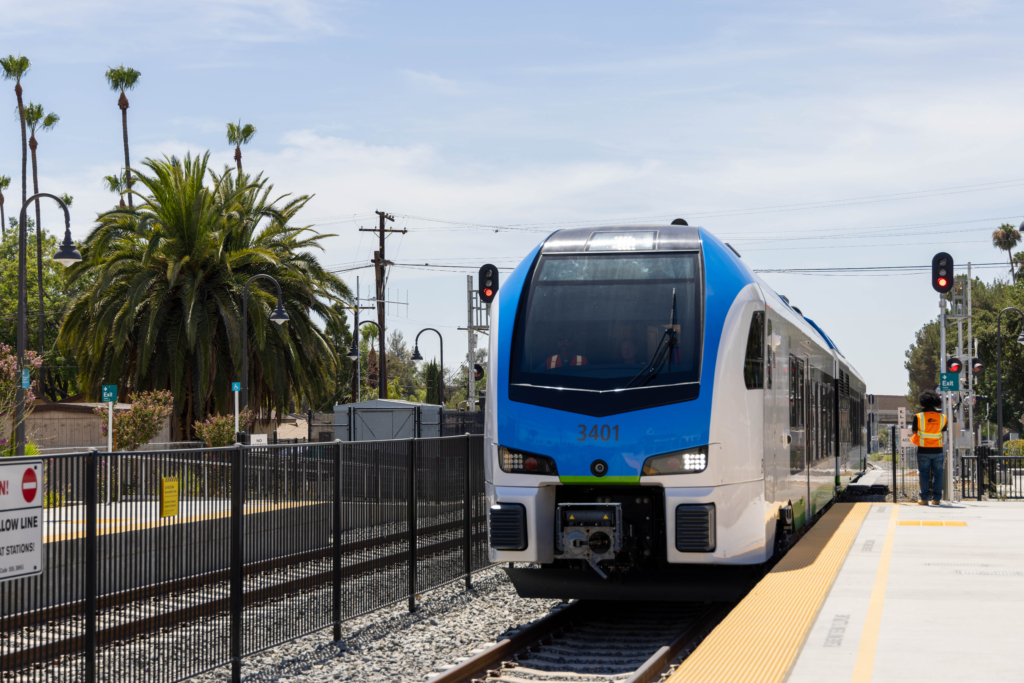
Separately, SBCTA and Metrolink have announced that a ribbon cutting ceremony for the Redlands Passenger Rail Project (Arrow) will take place on Oct. 21.
The nine-mile Redlands Passenger Rail Project is “an advanced regional transportation project designed to connect residents, businesses and visitors to a variety of leisure, education, healthcare and other destinations.” According to SBCTA and Metrolink, the rail project “provides new transportation choices through the implementation of a new rail service that integrates conveniently with other modes such as auto, bus and bicycle.”
DOWNLOAD THE REDLANDS PASSENGER RAIL PROJECT (ARROW) FACT SHEET BELOW:
Metrolink
APTA recently recognized Metrolink with Gold certification for its “achievements and targeted improvements to advance sustainability in the public transportation industry,” the agency announced Oct. 5. The APTA Sustainability Commitment “recognizes members who commit to becoming more sustainable in their operations and practices.”
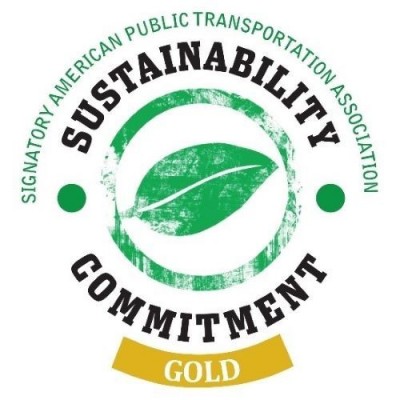
“As we continue to provide safe and reliable passenger rail service to help deliver mobility options and reduce vehicular emissions and roadway congestion across Southern California, Metrolink has shown leadership in preparing to be resilient in the face of climate change and in significantly reducing our environmental impacts in the region,” said Metrolink Chief Strategy Officer Paul Hubler. “We are pleased that our strong efforts across the Metrolink organization have been recognized by our transit industry peers with our first APTA Gold certification for sustainability.”
According to the agency, Metrolink received certification for “exceeding its board-adopted 2021 Climate Action and Social Impact Report that charts a course toward a zero-emission future for the agency.” According to Metrolink, its most notable achievements include reducing greenhouse gas (GHG) emissions and becoming the nation’s first passenger rail agency to completely power its entire fleet of locomotives with 100% fossil-free renewable fuel.
SEPTA
SEPTA is again expanding its institutional pass program, SEPTA Key Advantage, by inviting more organizations, including colleges and universities to participate.
SEPTA Key Advantage, which was initially launched on May 1, allows institutions to acquire SEPTA Key cards directly from the Authority and distribute them to employees.
Currently, SEPTA says more than 7,000 Drexel University, Penn Medicine and Wawa employees are using the passes after a “productive pilot program.” In June, SEPTA’s Board approved a tariff change to make the program permanent, and the Authority started accepting applications from businesses with 500 or more employees.
FMC Corporation, an agricultural sciences company globally headquartered in Philadelphia, is the first employer to join the program since the expansion, SEPTA says. FMC’s eligible employees are now able to enroll in SEPTA Key Advantage, and the passes will be ready to use on Nov. 1.
“We are excited to see a strong demand for this program,” said SEPTA General Manager and CEO Leslie S. Richards. “We appreciate the support from FMC and look forward to extending the benefits of SEPTA Key Advantage to more institutions.”
“FMC wanted to provide this benefit at no cost to employees to give them access to mass transit for their commutes, and so they could travel anywhere, anytime on SEPTA,” said FMC Vice President and Chief Human Resources Officer Kyle Matthews. “SEPTA Key Advantage gives our people the freedom to explore our great city in a way that’s consistent with the environmental commitments in FMC’s sustainability goals.”
FMC was one of the first major Philadelphia employers to bring employees back into the office on a flexible work plan once pandemic conditions allowed, FMC says, adding that SEPTA Key Advantage “complements other benefit partnerships the company offers,” like its meal program through Flik Hospitality Group, which provides breakfast, snacks, coffee and lunches in FMC Tower’s café to FMC employees at no cost.
“SEPTA is a great partner for us because of how many of our employees rely on their trains and buses to get to FMC Tower every day,” said FMC President and CEO Mark Douglas. “We believe strongly that FMC is at its best when we are working together in a collaborative environment like the one FMC Tower provides. We are very proud to provide SEPTA Key Advantage in order to make that easier for our employees.”
Medium-Sized Employers & Passes for College Students
As part of the next phase of the program’s rollout, the Authority says it is opening SEPTA Key Advantage to medium-sized companies with 50 or more employees beginning in January, which is when a new Philadelphia law takes effect requiring those businesses to offer commuter benefits to their workers. SEPTA plans to expand the program to small businesses soon, so all employers in the region will be able to offer SEPTA Key Advantage to their employees.
Also, SEPTA says it is now inviting colleges and universities to apply for the program in advance of the 2023 academic year. “SEPTA Key Advantage UPass will make it easier and less expensive for students to travel to school, work and other destinations,” the Authority says.
“SEPTA Key Advantage is already proving to increase ridership at partnering institutions,” said Richards. “Getting people on transit is a critical priority in our region’s pursuit of inclusive economic growth.”
Participants can use a new or existing SEPTA Key card for their pass. Just like the Monthly Anywhere TrailPass, the Authority says SEPTA Key Advantage passes can be used on all SEPTA modes, including Regional Rail, Market-Frankford Line, Broad Street Line, Norristown High Speed Line, and city and suburban buses and trolleys.
NJ Transit
IDC recently named NJ Transit’s multi-phase Innovation Train project as the overall winner of its second annual Best in Future of Digital Innovation North America Awards.
The Innovation Train project, according to NJ Transit, “spans R&D, implementation and specification development that overhauls outdated technologies used in the transit industry to connect all NJ Transit assets (vehicles, stations, track) to provide situational awareness, command, control, financial and communications operations.”
“No current single product can fulfill NJ Transit’s goals,” the agency said. As a result, NJ Transit “invented” the future—a “single stack” configuration of hardware, software and standard operating procedures. The team-built technology, the agency says, “delivers a private mesh network that integrates NJ Transit assets; 10G/s backbone providing internet access to the mesh; edge computing for video upload and analytics; onboard and station Wi-Fi; automated passenger analytics; UWB-based wayfinding; and IoT-based elevator/escalator monitoring.”
To accomplish this goal, NJ Transit built a laboratory at its headquarters and deployed the technologies for integration and testing. After confirming the technology, the Innovation Team installed the configured objects in four train stations and two trains. As a result, NJ Transit says, the time to offload video from vehicles dropped from 48 hours to 10 minutes–a reduction of 99.65%, which increased video storage length by 333%, allowing NJ Transit to forecast claims savings of up to $5 million annually.
According to IDC, the winning projects in its Best in Future of Digital Innovation North America Awards “successfully showcased the ability to source, augment, develop and/or distribute software IP (intellectual property) to deliver differentiation, disrupt the market through external products or services, or have a significant positive impact on internal operations.” Winners will be recognized during a live, virtual event on Nov. 2.
Additional Best in Future of Digital Innovation North America Award winners for 2022 include:
Edge Innovation Category Winner
PCL Constructors Inc. – Job Site Access: Job Site Access (JSA) is a cloud-based access control tracking platform designed and built in 2021 by PCL’s Business Technology department specifically to support the tracking, management, and control of workforce access on job sites promoting site security, safety, and efficient operations management. JSA is designed to scale to meet the demands of varying project sizes and configurations and provides flexible options based on specific construction, regional, security, or operational requirements. Projects can choose the type of monitoring access method from cost effective QR printed badges to innovative facial recognition biometric authentication methods as well as various hardware integration options from industrial grade turnstile gate structures, guard operated checkpoints, or self-service reader stations. The JSA solution enables field operations teams to be connected through remote mobile functions with the JSA Site Mobile app for iOS or Android devices. From simple worker tracking to complex authorization and security, Job Site Access is the security solution for smart connected construction sites providing a safer work environment by restricting unauthorized access, reducing opportunities for job site theft, and tracking time on site as a source to verify payroll or labor costs.
Innovation in Information Management Winner
National Fire Protection Association – NFPA LiNK: Developed by the National Fire Protection Association (NFPA), NFPA LiNK is an application-based platform containing real-time code information and situational content. Subscribers can add personalized notes in addition to bookmarking and sharing specific sections of code. With the flexibility to be used online or offline via mobile, tablet, laptop, or desktop devices, NFPA LiNK provides quicker access to crucial content while transforming the way information is delivered and used in the codes and standards industry. People around the world have turned to NFPA codes and standards to do their jobs efficiently and effectively for more than a century, but in recent years NFPA has seen a shift in the ways that people learn and do their jobs. Today’s workers do not find a physical book or a static digital version of a book to be the best means to help solve problems on a real-time basis. Instead, they want to connect the dots on safety and glean real-world, real-time understanding. With 54% of NFPA LiNK subscribers being first time NFPA customers, the platform has successfully reached a broad range of customers. Not only does NFPA LiNK support individuals, but the application also supports the differing needs of small businesses and large organizations.
“Winners in our annual Best in Future of Digital Innovation Awards represent those modern organizations that have successfully transformed from digital technology consumers to large-scale digital innovators,” said IDC Future of Digital Innovation Research Director Nancy Gohring. “We are thrilled to shine a spotlight on the organizations operating as digital innovation factories, building differentiating products and services to create greater value for customers and the business.”
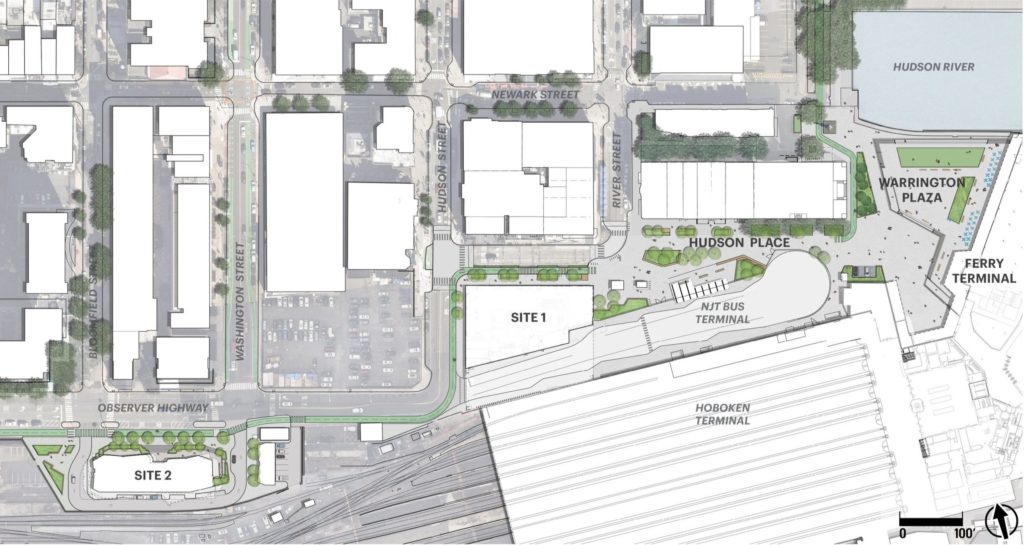
Separately, New Jersey Governor Phil Murphy on Oct. 5 commemorated the groundbreaking of a new development and public infrastructure improvement project near Hoboken’s historic train station. The “long-stalled” Hoboken Connect project, which had been in development for 15 years and was jump-started by the Murphy Administration through cooperation among various partners, including NJ Transit, LCOR and the City of Hoboken, will produce new office and retail space, affordable housing, and improvements to public infrastructure and the surrounding streetscape.
Hoboken Connect is a multi-phased initiative that consists of private and public components to be implemented in coordination over the coming five-plus years. When complete, NJ Transit says, the project will directly and indirectly support 15,290 permanent jobs and $234 million in tax revenue annually. According to the agency, the City of Hoboken will see 4,433 jobs on site with $9.6 million in annual retail spending and $4.5 million in annual revenue, while NJ Transit will benefit from ground lease payments, increased ridership and customer experience improvements. More than 9,800 construction jobs will be created, the agency adds.
The private phase includes a mixed-use residential building consisting of 389 apartment homes with 20% dedicated as affordable housing; a 20-story Class A office building with a rooftop terrace; 5,000 square feet of retail space; and related public open space investments, including additional pedestrian, vehicular and bicycle improvements.
“Made possible by a combination of vision, tenacity and public-private synergy, the Hoboken Connect project will serve as a microcosm of all that my Administration is determined to accomplish,” said Gov. Murphy. “In addition to incorporating environmentally sustainable design features, this long-awaited development will also produce millions of dollars in revenue for both Hoboken and NJ Transit. Just as crucially, this game-changing project will connect New Jerseyans to economic opportunity through affordable housing, public and active transportation options, and thousands of good-paying jobs.”
Public investments of Hoboken Connect, NJ Transit says, will include construction of a new bus terminal on Hudson Place; significant rehabilitation of the first and second floors of the Ferry Terminal for publicly accessible commercial and exhibition space; the redevelopment of Warrington Plaza; and improvements to Hudson Place to support bicycle and pedestrian access to the transportation facilities. Gov. Murphy and the Legislature committed $176 million during the FY2023 budget agreement to this project through the Debt Defeasance and Prevention Fund. All improvements, NJ Transit says, will be made utilizing historic preservation guidelines where applicable.
“Modernizing our transit infrastructure is a cornerstone of building sustainable communities that will pay dividends for generations to come,” said New Jersey Department of Transportation (NJDOT) Commissioner and NJ Transit Board Chair Diane Gutierrez-Scaccetti. “This project is an example of how the public and private sectors can come together to make our cities more walkable and transit oriented as we continue to limit our impact on climate change.”


